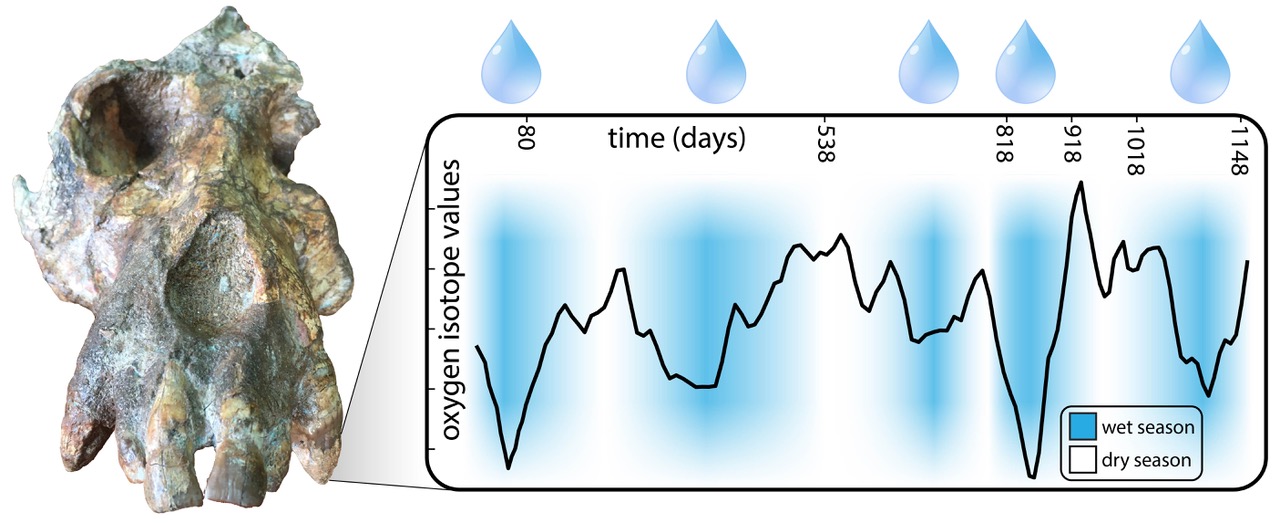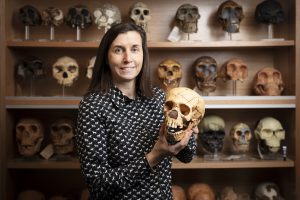
A global team of scientists has shown how microsampling oxygen isotopes in fossilised teeth can offer greater insights into the role seasonal climate and behaviour played in human and primate evolution.
The new study, published in the , examined the fossilised teeth of ancient mammals from a 17-million-year-old site in Kenya, including the enigmatic large-bodied ape known as Afropithecus turkanensis.
 To contextualize their study of these fossils, the researchers – led by Dr. Daniel Green from Columbia University and from Griffith University – measured oxygen isotopes (natural variants of oxygen) in modern primate teeth across Africa at near-weekly resolution.
To contextualize their study of these fossils, the researchers – led by Dr. Daniel Green from Columbia University and from Griffith University – measured oxygen isotopes (natural variants of oxygen) in modern primate teeth across Africa at near-weekly resolution.
In doing so, they found that their teeth recorded details of seasonal rainfall, environmental conditions, and animal behaviour. Heavier oxygen isotopes are known to be more abundant in drinking water and foods from dry regions and during periods of aridity.
The researchers also found that primate teeth could reflect human alterations to the landscape like the damming of rivers, and even provide indications of historical meteorological events.
Oxygen isotopes appeared to capture an extended drought in one case, and an extreme rainfall event in another individual, since the monkeys’ teeth were forming during the 1960s when these events occurred.
The authors then analysed oxygen isotopes in teeth from the fossil ape Afropithecus and compared their results with modern African primates, as well as ancient rainfall patterns simulated by cutting-edge climate models.
Their findings suggested the fossil apes experienced dry and wet seasons of variable intensity over time, and that the specialised tooth and jaw adaptations of Afropithecus would have supported the consumption of hard foods during seasons of drought or resource scarcity.
“This research has broad significance because seasonal changes in resource availability are thought to have influenced the evolution of great apes, early hominins, and modern humans,” said Professor Smith, from Griffith’s h and the .

Another key result is that fine-scaled isotopic variation within modern primate teeth demonstrated that the majority of tooth oxygen isotope studies of fossil hominins and other primates underestimated the environmental variation that shaped primate behaviour and evolution.
This study leveraged Australian innovations in ion microprobe sampling driven by Emeritus Professor Ian Williams of the Australian ³Ô¹ÏÍøÕ¾ University, who has been a pioneer in the development of their Sensitive High Resolution Ion Microprobe (SHRIMP) systems.
The use of the ANU SHRIMP permitted microscopic spots to be removed to measure oxygen isotopes recorded as the tooth was forming; this environmental window can be viewed with great precision, as tooth enamel has daily growth lines that can be visualised with light microscopy.
Dr. Green noted: “The effects of climate variation on the earliest African apes are poorly understood because detailed records of seasonal variation from this early period – the Miocene – are sparse.
“Isotope values from Afropithecus and closely associated herbivores suggest that apes in this part of eastern Africa were living in a seasonal forests or woodlands long before the origin of hominins. We may see the impact of that seasonal climate on the novel anatomical characteristics and behaviours of early apes.”
Smith, Green, and Williams have been working to refine and apply this powerful analytical approach to study living and fossil humans for the past five years.
Their landmark assessment of ancient seasonality from the teeth of Neanderthal children in 2018 led to their selection as finalists for the 2019 Eureka Award for Excellence in Interdisciplinary Research. They are currently planning to sample African fossil hominin teeth with funding from the Turkana Basin Institute.
The research was funded by Australian Research Council Discovery Project DP210101913 awarded to Smith, Williams and Green, and an Australian Academy of Sciences Regional Collaboration Programme award led by Smith.







